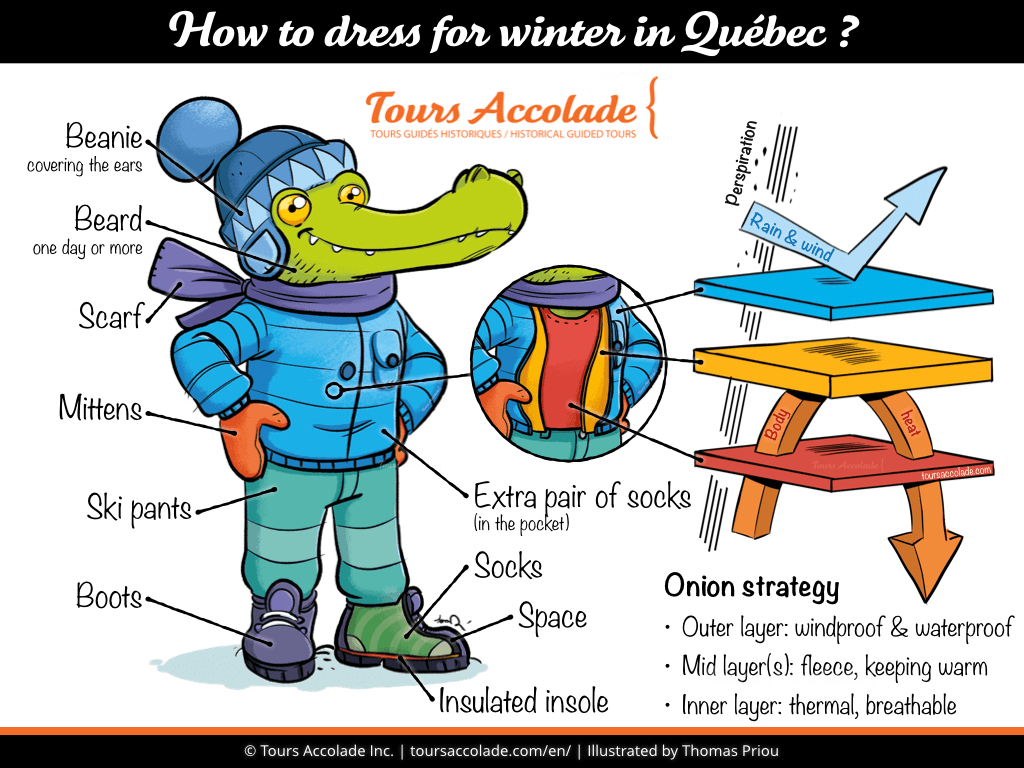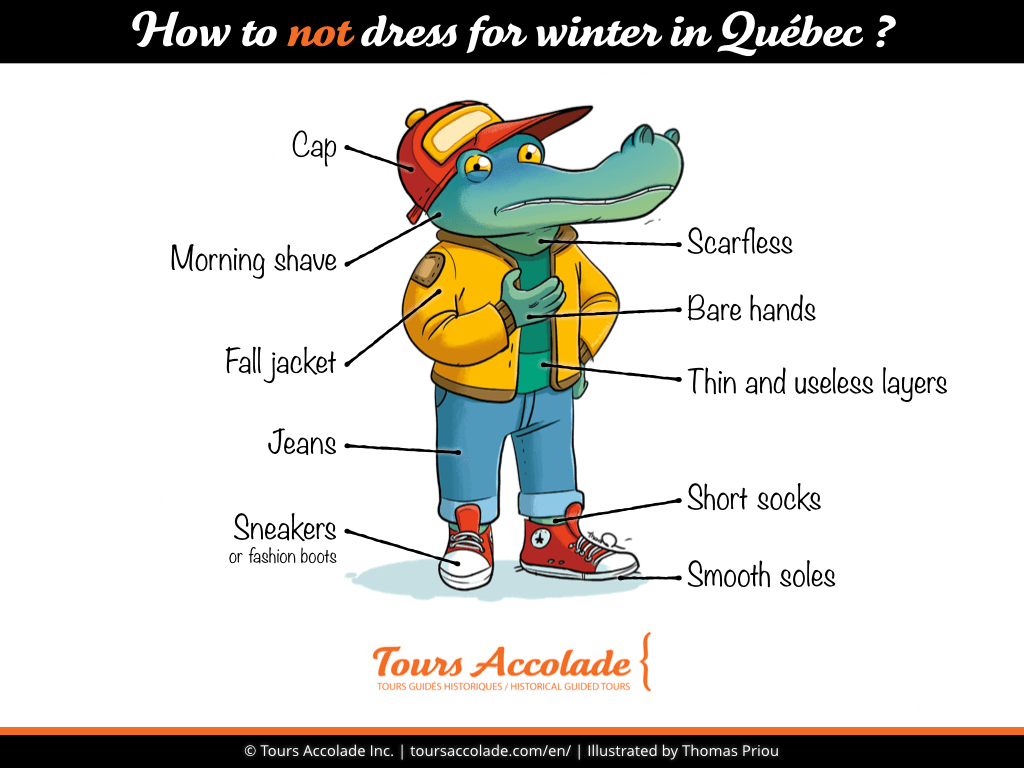Every year from November to March and sometimes April, Tours Accolade provides a two-hour Winter Walking Tour in Old Québec. Temperatures vary from the freezing point to -30˚C (-22˚F), sometimes even colder, plus wind chill factor. Staying warm is a challenge and cold toes can literally ruin the guided tour. That’s why customers receive instructions about how to dress appropriately for winter. Here are these instructions, available now for everyone.
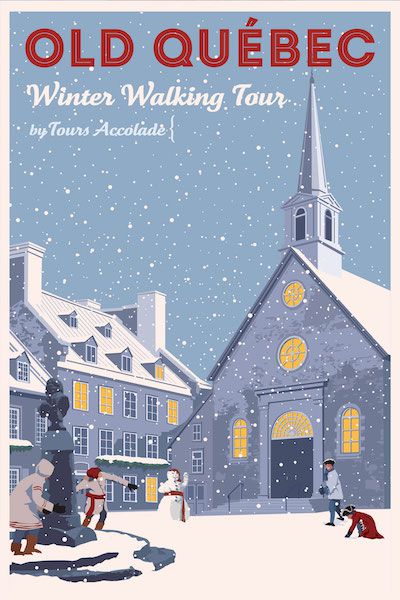
Staying warm outside during winter: a challenge for everyone
You might think these instructions are only useful for people coming from warm countries. After all, we could assume they know nothing about winter and cold temperatures. It could be hard for them just to imagine what -30˚C (-22˚F) could be! Even a freezer is warmer.
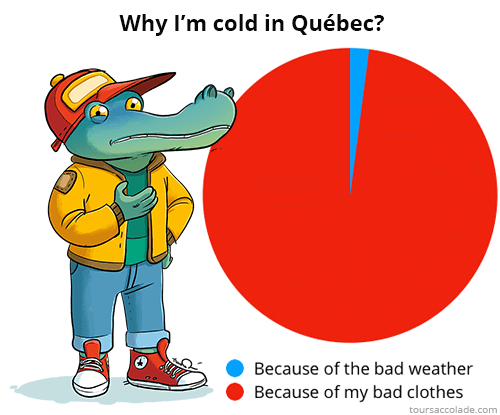
While people from cold areas, like Montréal, Toronto, Chicago or even New York City, they know, right? Well, not really. Think about it: most of the time we leave our home, we walk a couple of minutes outside to reach our car or public transport, then we walk again a little bit to go inside our warm working place or a shop. We don’t need to dress appropriately for winter because we barely spend 5 straight minutes outside and we’re moving. Enough to feel chilly, but not to freeze. Maybe it does sound familiar to you.
In comparison with our walking tour, we are outside for 2 hours, walking, but also standing in picturesque yet windy streets. The regular winter clothes we wear in a daily urban life are of no use. That’s why one should dress like he or she is going to hike or ski in the mountains.
By the way, when local families decide to spend a half day in Old Québec, they wear ski gear.
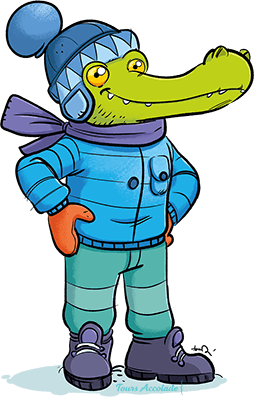
Instructions: how to dress appropriately for winter
It sounds easy to dress properly for a freezing winter: just layers of warm clothes. But it’s much more than that, it’s almost an art, especially for the feet. From head to toe, learn here how to not freeze during the cold season, how to feel like you are in a warm cocoon in the midst of winter.
If you want to grasp the ins and outs, please read carefully all the details and tips. Keep in mind, this article is written for the lucky travelers visiting Old Québec. You’ll be able to reuse all these instructions in every other cold environment like Canada, Russia and any Nordic country. Nonetheless, some activities like ice fishing, snowmobiling or winter running may require different information, which we won’t cover here.
The onion strategy
Your body generates heat and sweat (perspiration). Your clothes are here to retain that heat, to get rid of the moisture to keep you as dry as possible and to protect you from the elements: wind, rain, snow, icy rain. It’s hard to find a good balance between thermal insulation, impermeability, breathability and durability (or need for care). You can add environmental sustainability, animal welfare and social responsibility as critera too. No fabric is perfect, that’s why the idea is to have several layers, like an onion, each layer having specific properties and strengths.
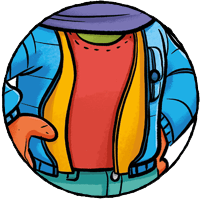
There are three kind of layers :
- The outer layer, or protective layer, is your shell. It must be waterproof and windproof, but still breathable. Patented fabrics like Gore-Tex or Sympatex are designed for this layer, but vents can be enough to get rid of moisture.
- The mid layer is there to keep your body warm thanks to thermal insulation. You can wear more than one mid layer: a fleece pullover under an insulated coat for example. It also needs to be breathable.
- The inner layer (or base layer) is there for the comfort of your skin by keeping it dry. In order to wick away any excess of moisture, it’s better when this layer is directly on your skin without being too tight. It doesn’t need to be insulated, but it can. Clothes made of synthetic or merino wool are perfect, especially because they can dry fast and/or they keep their good properties even if damp. They must be super breathable.
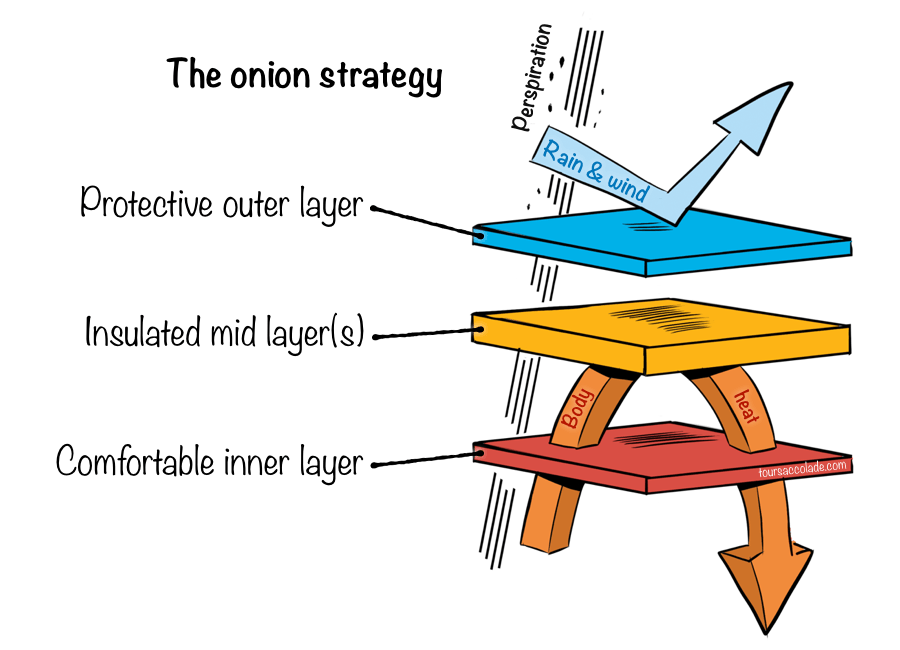
You don’t necessarily need one piece of clothing per layer. Some clothes are good for 2 layers, like most of the coats, parkas and jackets: windproof & waterpoof (outer layer) but also insulated (mid layer). Same thing with most of the boots and ski pants. Many clothes sold as base layers are insulated as well.
With time and experience, you’ll find the right number of mid layers. It also depends on your activity level, the quality and quantity of your mid layers and your cold sensitivity.
Extra tip
As soon as you feel you are overheating, simply remove or open a mid-layer, which could be the coat itself, since it usually does include an insulated layer. You have to do the same when you are in a warm place. Because if you overheat, you sweat; subsenquently, your inner layer may not dry fast enough and then your damp skin makes you feel chilly.
Pick your outfit with the right fabrics
Lightness and thickness are good clues but aren’t reliable enough.
You certainly have to avoid cotton and other plant-based fibres like linen, lyocell, hemp, tencel and bamboo. Articles that suggest wearing such fabrics approach the winter topic from a fashion perspective. We know fashion does matter, but our priority is for you remain toasty after countless hours outside. Plants are designed to absorb and keep water. Cellulose fibres made from plants are absorbent, they soak up the moisture, they retain it and most of the time they won’t dry out quickly enough. Plant-based fibres are pretty useless for real winter conditions and dangerous for the inner layer, because a damp skin can lead to hypothermia.
Your skin must remain dry.
That’s why we’ll advise you to turn to wool (alpaca, angora, cashmere, flannel, lambswool, merino), fur, synthetic (polyester, polypropylene, acrylic, spandex, nylon), down or even silk (inner layer). Some are slightly more expensive, but it’s worth it because of the insulation, comfort or style.
When buying your clothes or picking them from your wardrobe, take the time to carefully scan all composition labels and make sure there is not too much vegetal fibres and not a single percentage of it for the inner layer. Cotton is very common, be careful.
Extra tip
Your outfit should not be tight. Air being the best insulator, it is preferable to choose loose clothes, or at least snug.
Head: cover it carefully

Forget the baseball caps! You need a real warm beanie that covers the ears. A polar fleece lining is a nice addition. It doesn’t need to be waterproof & windproof as long as you have a hood with your coat.
Covering the mouth is often unnecessary and will make matters worse by freezing the layer due to the moisture from your breath. A fur or faux fur trim on your hood will do a decent job to protect your face from the wind. If it’s too cold and you worry about frostbite, pull up your neckwarmer or wear a balaclava, but do not cover your mouth.
Wear a warm scarf or a neck warmer. This accessory covers your neck and also seals the top of your jacket.
Extra tips
• Use a lip balm… It’s better than wetting your lips with your tongue, which is the best way to get cracked lips !
• Men: never shave your face the morning, always do it in the evening or… never.
Torso & arms: choose your coat wisely

Don’t skimp on the coat, jacket or parka. It must be waterproof, windproof, but still breathable to let the sweat evaporate. If it’s not well insulated, it must be large enough to let you wear other mid-layers.
Must have accessories and details:
- Sealed seams because rain often seeps through them.
- Storm flap covering the zipper.
- Hood.
- Long enough to cover the hips, at least partially.
- Manufacturer specifying the temperature sustainability.
Many jackets are designed for specific activities, take it into consideration. Some jackets will keep you warm even if you don’t move, some will require a physical effort.
Depending on the insulation efficiency of your coat, you’ll wear more or less mid layers such as fleece pullover or flannel shirt. If you’re not sure and to avoid overheating, it’s better to start with fewer layers and then add some if necessary.
Finally there’s the inner layer: any adjusted base layer long sleeve sweater that is highly breathable and quick-drying will suit.
Extra tip
Your coat will be efficient for years if you take care of it. Respect the manufacturer instructions to clean it or, better, visit your local dry cleaner.
Hands: keep the fingers together

Keep your little gloves at home. Use mittens instead. Your fingers will be like penguins: all together, they will keep themselves warm. Keep in your pocket a spare dry pair of mittens, in case you touch something wet or start to sweat too much.
Even with the best mittens, sometimes we can get cold fingers. Hopefully it is really easy to warm them up. Make a wide and fast rotary movement with your arms: it will help to get the blood flowing to the tips of your fingers. Be careful and check there is nothing nearby because you could hurt yourself or others. We can do a demonstration during the tour itself.
Extra tip
Never blow in your mittens: you’ll add a lot of warm moisture, you’ll feel comfortable for one minute and then you’ll feel cold and won’t be able to dry your mittens.
Legs: like when you are skiing
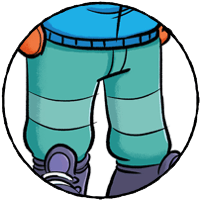
Ski pants are amazing: they are both windproof and waterproof, they are insulated and they are comfortable. Usually you can even open them with zippers on the inner parts of the thighs to cool down and to let the sweat evaporate more quickly. You could use tights as base layer, but that’s not always necessary.
Even though the legs are less sensitive to the cold and perspire less than other body parts, do not wear jeans: they’re not waterproof, not windproof, not even warm and they are made of cotton.
Feet: the challenge
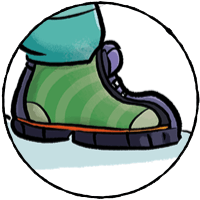
Like for the rest of the body, your goal is to keep the feet dry and warm. Unfortunately it’s tricky to keep them dry…
A good boot has 3 qualities:
- Warm.
- Waterproof but breathable.
- A rugged rubber sole designed to grip on ice and snow.
For comfort and safety, your feet should be tight in your boots, but not too tight either as they need to let the blood flow properly and keep air for insulation. That’s the key. You could have the best boots but if they don’t fit correctly, your feet will cool down.
The easiest, but most expensive, is to use real fur boots. Even when there’s moisture, you’ll feel like you’re wearing warm slippers. If you walk in streets with them, wash them carefully when you come back home (to get rid of salt, calcium, dirt, etc.) in order to assure their durability.
The most underrated accessory is the thermal/insulated insole. Add one or more insole per boot, most of them need it. Have it in mind or even try them when you shop for your boots: they must be big enough for your feet and the insulated insoles.
For the socks:
- Buy several kinds of warm socks (thin, thick, wool, synthetic, etc.) and try them with your boots.
- They don’t need to be super expensive to be efficient.
- Always keep in your pocket one extra pair of clean and dry socks.
The most common mistakes people make :
- Wool socks with cotton: be very careful and check the composition label, because sometimes items sold as “wool socks” do have a significant percentage of cotton. Remember, your socks should have no cotton, niet, nada.
- More than pair of socks: people sometimes do it to multiply the mid layers. Yes, technically, it could work and sometimes it does. Unfortunately most of the time the feet will be too tight and/or a sock will slip under the foot. It will get uncomfortable. It’s better to avoid that technic. Have one good pair of socks and add insulated insoles.
- Choosing tight boots. That’s a mistake people often make because they shop their boots with thin socks and later they wear thicker socks, add thermal insoles…and inevitably it gets too tight !
Extra tip
Hot pads for toes are much better (and cheaper) than hot pads for feet. It’s more comfortable to put them over the toes rather than under them.
Last tips for winter
Here are some extra tips to become a real warm Yeti:
- As soon as you come back home and remove your boots (and the insoles inside): dry them (with crinkled-up newspaper)! Same thing for everything you’re going to wear again soon (coat, mittens, scarf, ski pants).
- Drink something warm before going outside and stay hydrated. Do not drink alcohol, or at least not too much, it doesn’t help to warm up the body.
- Eat well before going outside: your body needs energy to heat, your clothes are just keeping that heat. Of course we recommend the famous poutine.
- Traveling with teenagers, who are ignoring these instructions? Bring some extra warm clothes for them, without their consent… later they will be grateful.
- Keep your phone close to your warm body to preserve its battery.
- To help your skin retain its natural oils, don’t use products with alcohol or astringents on your face. Use moisturizing balms (lips) and sunscreen (face).
- Eat a traditional French onion soup at the end of your day (we share the best spots in Québec City during the tour).
What do I wear?

I personally spent a lot of time in the streets of Québec City. I saw many people uncomfortable and freezing with jeans, while I wear ski gear all winter long. None of what’s going to follow is sponsored:
- Beanie: Christophe tuque from Chlorophylle, acrylic and wool, that’s a hat I got for working at the Hôtel de Glace, it’s just perfect.
- Neck warmer: basic no-brand.
- Coat and pants: a good old Etirel ski coat with its pants. My next purchase will maybe be a Chlorophylle for both coat and ski pants after wearing this brand as uniform at the Hôtel de Glace. Sometimes I also wear thermal pants under the ski pants.
- Under the coat: they’re so efficient I usually wear a flannel shirt or a Thermolactyl Damart. The few coldest days of the season (around -30˚C / -22˚F) I wear both.
- Mittens: unfortunately, Garneau doesn’t sell the fantastic mittens I bought 7 years ago and none of their current products look like what I got. As backup I’ve basic thin flip-top mittens like this, they’re not warm, but windproof.
- Socks: I had EXP thermal’s socks for a long time, especially because they are cheap, but I walk too much and destroyed too many of them each winter. I’ll recommend them if you don’t plan to wear them often. Now I usually wear the essential merino wool socks or the merino wool ribbed socks both from Le 31 by Simons, even if they need to be washed by hand.
- Boots: Keen Summit County Waterproof boots (now Revel IV high polar boot). They are warm like many shoes and boots I have had, but they are by far the most versatile: from snowshoeing in the woods to walking in the streets, they’re always comfortable.
Finally I always carry an Echinaforce Sore Throat Spray from A.Vogel and a bottle of water or warm tea with me.
Wrapping up the instructions to dress appropriately for winter
Here are the few basic rules to follow:
- The onion strategy: one protective outer layer that is windproof and waterproof covering one insulated mid layer or more to keep you warm covering one comfortable inner layer keeping your skin dry for comfort, and ultimately for safety.
- Choice of clothes: NO cotton or any plant-based fibre. Everything you wear must be made of wool, down, synthetic, fur or a mix of these fabrics. Everything should be loose, or at least snug, except the inner layer, which should be snug.
- Head : protect it carefully, make sure you have a warm beanie that covers the ears. A coat with a windproof hood and a fur trim is always good. Have a proper warm scarf or something warm to cover your neck.
- Hands : keep the fingers together and wear mittens rather than gloves.
- Torso and arms: choose your coat wisely. It must be windproof & waterproof, insulated and have a hood. Remove or open mid layers as soon as you overheat.
- Legs, just as if you would go skiing : no jeans, not even with layers under it, simply wear ski pants.
- Feet : only one pair of dry and warm socks (once again, no cotton), one (or more !) insulated insoles inside warm waterproof boots. Keep one extra pair of dry socks in your pocket. Make sure that you don’t wear footwear that is too narrow or tight. Hot pads for the toes if necessary.
This illustration made by Thomas Priou shows the essential. The character is an alligator from Florida taking our warnings seriously and following the instructions to the letter. Look how he does look happy!
Now you can enjoy winter for hours
Rather than spending your holidays or free time inside a boring building because outside you’re freezing, thanks to these instructions and tips you’ll be able to spend countless hours outside, enjoying nature, architecture, heritage and winter activities.
Did you like this article? Feel free to share it to your friends:
We’ll also be happy you join us on Facebook.
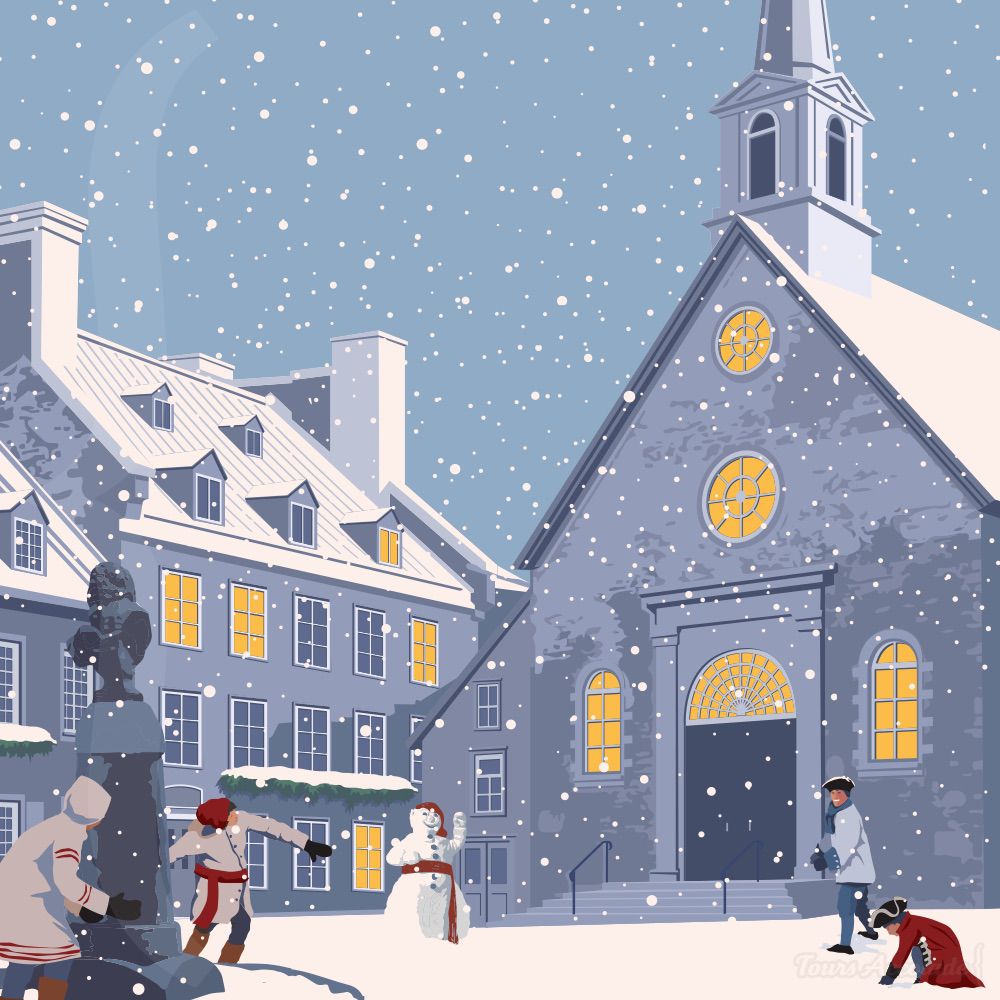
Our tours in winter
If you’re planning to visit Quebec City, the first activity you should book is our Winter Walking Tour of Old Québec. This is a great introduction to local history and architecture. Travelers like to start with us to better appreciate local heritage and be able to orient themselves.
Special thanks to Thomas Priou for the beautiful illustrations he did for Tours Accolade.


